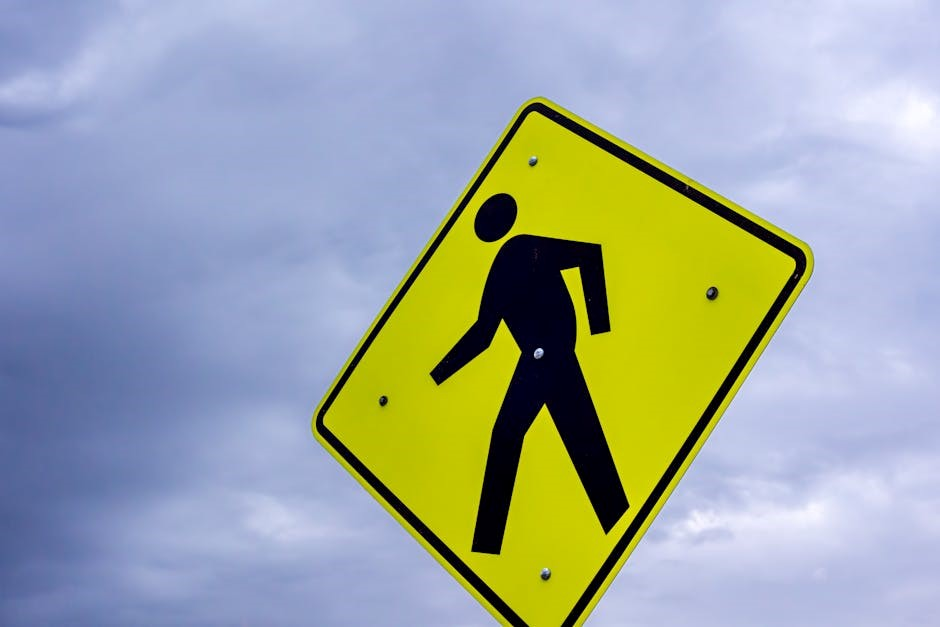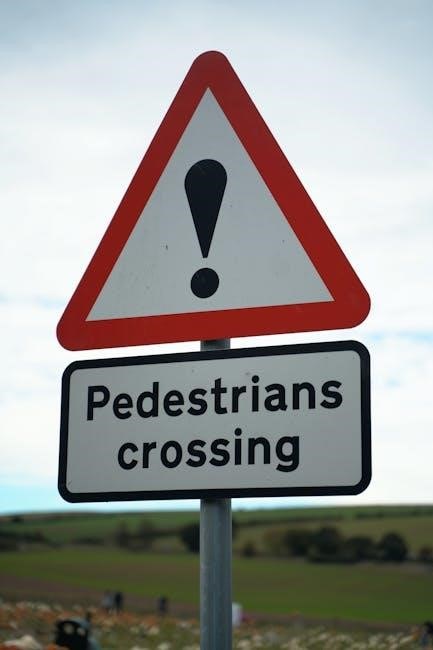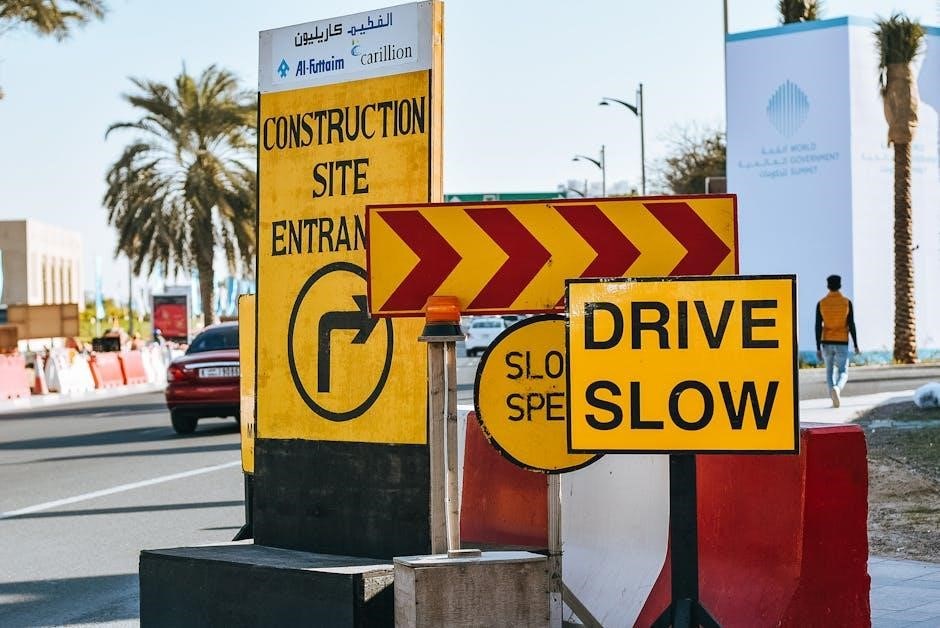
Indiana road signs are essential for ensuring safety and smooth traffic flow․ They use colors, shapes, and symbols to guide, warn, or inform drivers․ This guide helps you understand these signs, crucial for safe driving and obtaining a driver’s license in Indiana․
Importance of Understanding Road Signs
Understanding Indiana road signs is crucial for safe and efficient driving․ Road signs convey critical information through colors, shapes, and symbols, helping drivers make quick decisions․ They ensure safety by alerting drivers to potential hazards, directing traffic flow, and enforcing regulations․ Recognizing these signs is a legal requirement for obtaining a driver’s license and essential for minimizing accidents․ Whether you’re a new or experienced driver, comprehending road signs helps you navigate Indiana’s roads confidently and responsibly, ensuring the safety of yourself, passengers, and pedestrians․
Overview of the Indiana Road Signs Study Guide
The Indiana Road Signs Study Guide is a comprehensive resource designed to help drivers understand and recognize traffic signs․ It covers various types of signs, including regulatory, warning, construction, and guide signs․ The guide uses clear explanations, visuals, and practice tests to aid learning․ It emphasizes the importance of road sign recognition for safe driving and obtaining a driver’s license․ By following this guide, drivers can gain confidence in navigating Indiana’s roads securely and efficiently, ensuring compliance with traffic laws and enhancing overall road safety․

Types of Road Signs in Indiana
Indiana road signs are categorized into regulatory, warning, construction, and guide signs․ Each type communicates specific information to ensure safe and efficient travel for all road users․
Regulatory Signs
Regulatory signs enforce traffic laws and provide clear instructions to drivers․ They include speed limit signs, stop signs, yield signs, and turn restrictions․ These signs are essential for maintaining order on the road and ensuring compliance with traffic regulations․ For example, speed limit signs indicate the maximum allowable speed, while stop signs require drivers to come to a complete halt․ Regulatory signs often feature white backgrounds with black text or symbols, making them easily recognizable․ Disregarding these signs can result in penalties, making them a critical focus for any driver․ Understanding and obeying regulatory signs is vital for safe and lawful driving in Indiana․
Warning Signs
Warning signs alert drivers to potential hazards or changing road conditions ahead․ They are crucial for safety, helping drivers prepare for unexpected situations․ These signs are typically yellow with black symbols or text, making them highly visible․ Examples include curve warnings, pedestrian crossings, and animal crossings․ They often feature universal symbols to ensure quick comprehension․ Warning signs prepare drivers for conditions like sharp turns, merging traffic, or school zones, allowing them to adjust speed and behavior․ Understanding these signs is essential for anticipating hazards and maintaining safe driving practices․ They are a key component of the Indiana road signs study guide, emphasizing proactive driving strategies to prevent accidents․
Construction and Maintenance Signs
Construction and maintenance signs inform drivers about roadwork, detours, or temporary conditions․ These signs are essential for ensuring safety in work zones․ They are typically orange with black text or symbols, standing out in active construction areas․ Examples include “Road Work Ahead,” “Detour,” and “Lane Closed․” These signs help drivers anticipate and navigate around work zones safely․ Understanding them is crucial to avoid confusion and potential hazards․ They guide drivers through temporary traffic patterns, ensuring smooth flow and reduced accidents․ Construction and maintenance signs are a vital part of the Indiana road signs study guide, emphasizing safety in dynamic road environments; They prepare drivers for unexpected changes․
Guide Signs
Guide signs provide essential directional and informational guidance to drivers, helping them navigate highways, urban areas, and tourist destinations․ These signs are typically green or blue with white text and are designed to be easily readable at a glance․ They include directional signs for exits, interchanges, and points of interest, as well as informational signs for services like rest areas, gas stations, and restaurants․ Guide signs are crucial for reducing driver confusion and stress, especially in unfamiliar regions; They ensure smooth travel by clearly indicating routes and services, contributing to efficient and safe road navigation across Indiana․

Regulatory Signs in Detail
Regulatory signs enforce traffic laws and ensure safety by providing clear instructions․ They include speed limits, stop/yield signs, and turn restrictions, all designed to control traffic flow effectively․
Speed Limit Signs
Speed limit signs in Indiana indicate the maximum legal speed for vehicles on specific roads․ These signs are circular, with a black background and white numbers, ensuring visibility day and night․ They help drivers adjust their speed according to road conditions, reducing accidents․ Speed limits vary based on location, with lower limits in urban areas and higher on rural highways․ Disregarding these signs can lead to traffic citations or dangerous situations․ Obedience to speed limit signs is crucial for maintaining traffic flow and road safety, making them a fundamental part of the Indiana road signs study guide․
Stop Signs and Yield Signs
Stop signs and yield signs are essential regulatory signs in Indiana․ Stop signs are octagonal and red, requiring drivers to come to a complete halt․ Ignoring them can result in accidents or citations․ Yield signs are triangular with a white background and red border, signaling drivers to slow down and prepare to stop if necessary․ Both signs are crucial for maintaining traffic order and safety; Recognizing and obeying them is vital for preventing collisions and ensuring smooth traffic flow․ These standardized signs play a key role in driver education and road safety across Indiana, enhancing overall driving experiences․
Turn Restrictions and Traffic Signals
Turn restrictions and traffic signals are critical for managing traffic flow in Indiana․ Turn restriction signs indicate when drivers cannot make a left, right, or U-turn, often specifying times or days․ Traffic signals use red, yellow, and green lights to control traffic movement․ Red signals require a stop, yellow signals warn of an impending red light, and green signals allow vehicles to proceed․ Arrow signals, displayed above lanes or on signal heads, indicate when turns are permitted․ Understanding traffic signal phasing and right-turn-on-red rules is essential for safe navigation․ These signs and signals help prevent accidents and maintain orderly traffic flow across Indiana roads․

Warning Signs in Detail
Warning signs alert drivers to potential hazards or changes in road conditions․ They are diamond-shaped with yellow backgrounds and black symbols or text, preparing drivers for upcoming risks like curves, intersections, or pedestrian crossings․
Curve and Intersection Signs
Curve and intersection signs warn drivers of upcoming turns or crossings, helping to prevent accidents․ These signs are often chevron-shaped or feature arrows, indicating sharp turns or merging lanes․ Yellow backgrounds with black symbols are standard․ For example, a curved arrow sign signals a upcoming turn, while a crossroad sign alerts drivers to an intersection ahead․ These signs are crucial for adjusting speed and positioning, especially in areas with limited visibility․ Familiarizing yourself with these signs ensures safer navigation through Indiana’s diverse roadways, from urban intersections to rural curves․
Pedestrian and School Zone Signs
Pedestrian and school zone signs are essential for ensuring safety in areas with high foot traffic․ These signs alert drivers to be cautious and reduce speed․ Pedestrian Crossing signs, often rectangular with a walking figure, indicate where pedestrians may cross․ School Zone signs, typically yellow and diamond-shaped, signal areas near schools․ Some include flashing lights to emphasize speed limits during school hours․ These signs help protect vulnerable road users, making it critical for drivers to obey them strictly․ Recognizing and adhering to these signs is vital for preventing accidents and ensuring the safety of children and pedestrians in Indiana․
Animal Crossing and Falling Rock Signs
Animal crossing and falling rock signs are crucial for driver safety in Indiana․ Animal Crossing signs, typically yellow and diamond-shaped with an animal silhouette, alert drivers to areas where wildlife may enter the road․ These are common near forests or rural areas․ Falling Rock signs, also yellow and diamond-shaped, warn of loose rocks that might fall onto the roadway, especially near cliffs or steep terrain․ Both signs require drivers to exercise caution, reducing speed and staying alert to potential hazards․ Recognizing these signs helps prevent accidents and ensures safe travel through Indiana’s diverse landscapes․

Construction and Maintenance Signs
Construction and maintenance signs in Indiana are orange, informing drivers of roadwork, detours, or closures․ These signs ensure safety and smooth traffic flow through work zones․
Detour and Road Closure Signs
Detour and road closure signs in Indiana are essential for redirecting traffic due to construction or emergencies․ These signs are typically orange or yellow, featuring clear arrows or “Detour” text․ They guide drivers safely around closed roads, ensuring smooth navigation․ Road closure signs often display “Road Closed” or “Do Not Enter” messages, while detour signs provide alternate route information․ Recognizing these signs is crucial for avoiding unsafe areas and following designated paths․ Always follow detour instructions to maintain safety and comply with traffic regulations․ These signs help minimize disruptions and prevent accidents in work zones or restricted areas․
Lane Shift and Merge Signs
Lane shift and merge signs in Indiana are designed to guide drivers through areas where traffic lanes change or merge․ These signs often feature arrows or chevrons to indicate shifts in lane alignment․ Merge signs, such as “Merge Ahead” or “Lane Ends,” alert drivers to approaching lane reductions, helping them prepare to adjust their speed or position․ Recognizing these signs is crucial for maintaining safe distances and smooth transitions․ They are commonly used in construction zones or areas with varying traffic patterns to ensure efficient and safe traffic flow․ Always follow directional arrows and adjust your driving accordingly to prevent accidents․
Work Zone and Flagging Signs
Work zone and flagging signs in Indiana are essential for maintaining safety in construction or maintenance areas․ These signs, often orange in color, alert drivers to changes in traffic patterns or road conditions ahead․ Examples include “Road Work Ahead” and “Workers Present․” Flagging signs may also indicate when flaggers are present to direct traffic flow․ Always reduce speed and follow instructions from flaggers or signs to ensure the safety of workers and other drivers․ Obeying these signs is crucial to prevent accidents and fines in work zones․

Guide Signs in Detail
Guide signs provide directions, distances, and services, helping drivers navigate Indiana roads efficiently․ They are typically green and white, placed at intersections, exits, and interchanges to assist route planning․
Directional Signs
In Indiana, directional signs guide drivers toward cities, towns, and key destinations․ These signs are typically green with white text and arrows, clearly indicating directions․ They often appear at intersections, exits, and interchanges to help motorists choose the correct route․ Directional signs may display multiple destinations, offering a quick reference for drivers․ For example, they might show directions to major highways, such as I-65 or I-70, or nearby cities like Indianapolis or Fort Wayne․ These signs are essential for navigating Indiana’s road network efficiently, especially for unfamiliar travelers․ Accurate and visible directional signs ensure safe and stress-free travel across the state․
Informational Signs
Informational signs in Indiana provide helpful details to drivers, enhancing their travel experience․ These signs typically feature blue backgrounds with white text and symbols, offering information about rest areas, hospitals, and tourist attractions․ They often include logos or symbols for services like food, lodging, and fuel․ Some signs highlight points of interest, such as historical landmarks or parks․ Informational signs are designed to be easily readable at a glance, ensuring drivers can quickly access the details they need without distractions․ They play a crucial role in aiding navigation and promoting local services, making them indispensable for both residents and visitors navigating Indiana’s roads․
Destination and Service Signs
Destination and service signs in Indiana guide drivers to specific locations and services․ These signs often feature green backgrounds with white text and arrows, directing motorists to cities, airports, hospitals, and other key destinations․ Service signs, typically blue, indicate nearby amenities like food, gas, and lodging․ They are strategically placed near interchanges and along highways to help travelers make informed decisions without distractions․ Universal symbols and clear typography ensure readability, making them essential for navigating Indiana’s roadways efficiently․ These signs simplify travel planning, helping drivers reach their destinations or find necessary services quickly and safely․

Traffic Signals and Pavement Markings
Traffic signals and pavement markings regulate flow, ensure safety, and guide drivers․ Signals include red, yellow, and green lights, while markings like lines and arrows provide visual direction․
Understanding Traffic Lights
Traffic lights are essential for controlling the flow of vehicles and pedestrians․ Red indicates “stop,” while green means “go․” Yellow signals a transition between red and green․ Arrows on traffic lights guide turning directions, ensuring safe lane changes․ Pedestrian signals, such as walking person or countdown timers, help pedestrians cross safely․ Flashing lights often indicate caution or four-way stops․ Understanding traffic lights is crucial for obeying traffic laws and preventing accidents․ Always come to a complete stop at a red light and yield to others when necessary․ Familiarity with these signals enhances safety and smooth traffic movement;
Recognizing Arrow Signals
Arrow signals are crucial for guiding drivers through intersections and lane changes․ Green arrows indicate when turning is allowed, while yellow arrows warn of an upcoming change․ Red arrows mean turning is prohibited․ These signals often appear on traffic lights or overhead signs․ Left-turn arrows are common at busy intersections, while straight arrows guide through lanes․ Always follow arrow signals to avoid conflicts and ensure smooth traffic flow․ They help reduce accidents by clarifying safe movements․ Pay attention to arrow timing to navigate safely and efficiently․ Recognizing these signals is key to responsible driving in Indiana․
Interpreting Lane Dividers and Crosswalks

Lane dividers and crosswalks are essential for organizing traffic and ensuring pedestrian safety․ Solid lines on roads indicate where changing lanes is prohibited, while dashed lines allow lane changes when safe․ Crosswalks, marked by parallel lines, signal where pedestrians can cross․ Diagonal lines often warn of merging lanes․ hashed lines near crosswalks emphasize pedestrian priority․ Always yield to pedestrians in crosswalks and follow lane markings to maintain order․ These markings help prevent accidents and guide drivers through complex intersections․ Understanding them is vital for safe and efficient navigation on Indiana roads․

Best Practices for Studying Indiana Road Signs
Mastering Indiana road signs requires consistent review of the study guide, utilizing online resources, and practicing with flashcards․ Regularly test your knowledge with quizzes to ensure retention and understanding․
Using Online Resources and Practice Tests
Leverage online resources and practice tests to effectively study Indiana road signs․ Interactive platforms offer simulations of real-world scenarios, helping you understand sign meanings in context․ Take practice tests regularly to assess your knowledge and identify weak areas․ Many websites provide flashcard-style quizzes and detailed explanations to improve retention․ The Indiana DMV website offers official study materials, ensuring accuracy․ Additionally, mobile apps like Driver’s Ed Guru and DMV Genie provide convenient, on-the-go study options․ Consistent use of these tools will enhance your familiarity with Indiana road signs and boost your confidence for the test․
Reviewing the Indiana Driver’s Manual
The Indiana Driver’s Manual is a comprehensive resource for learning road signs․ Published by the Indiana Bureau of Motor Vehicles (BMV), it includes detailed descriptions and images of signs, along with explanations of their meanings and importance․ The manual covers regulatory, warning, construction, and guide signs, ensuring a thorough understanding of each category․ It also outlines Indiana-specific traffic laws and driving rules, providing context for how signs are used in real-life situations․
Regularly reviewing the manual helps reinforce your knowledge and prepares you for the driver’s test․ Focus on sections dedicated to road signs, but also read the entire manual to understand how signs function within broader traffic regulations․ This approach ensures a well-rounded understanding of Indiana road signs and safe driving practices․
Practicing with Flashcards and Quizzes
Flashcards and quizzes are effective tools for mastering Indiana road signs․ Flashcards allow you to memorize signs quickly, with the sign on one side and its meaning on the other․ Quizzes test your knowledge in a timed setting, simulating real test conditions․ Online platforms and apps offer interactive quizzes, while flashcards can be homemade or downloaded․ Regular practice builds familiarity and confidence․ Set aside time daily to review and track your progress․ Consistent practice ensures you can identify and interpret signs accurately, preparing you for the driver’s exam and safe driving․
Mastering Indiana road signs is essential for safe and confident driving․ This guide provides a comprehensive review of signs, ensuring you understand traffic rules and stay informed․
Final Tips for Mastering Indiana Road Signs
To master Indiana road signs, consistent practice and review are key․ Start by understanding the basic categories: regulatory, warning, construction, and guide signs․ Use online resources like practice tests and flashcards to reinforce learning․ Pay attention to real-world examples while driving to connect signs with their meanings․ If unsure about a sign, consult the Indiana Driver’s Manual for clarification․ Regularly review updated signs to stay informed about changes․ Teaching others can also help solidify your knowledge․ Remember, mastery is a continuous process that enhances safety and confidence on the road․ Stay vigilant and keep practicing!

Staying Updated on Road Sign Changes
To stay updated on Indiana road sign changes, regularly check the Indiana Department of Transportation (INDOT) website for updates․ They often publish new signage guidelines and modifications․ Additionally, review the Indiana Driver’s Manual periodically, as it reflects the latest signage information․ Subscribe to traffic safety newsletters or follow INDOT’s social media accounts for real-time updates․ Attending local traffic safety workshops or community meetings can also provide insights into recent changes․ Downloading mobile apps designed for driver education can offer interactive updates on road signs․ Always verify information through official sources to ensure accuracy․